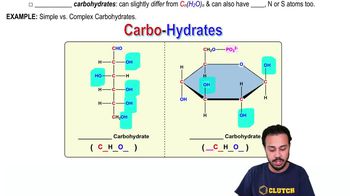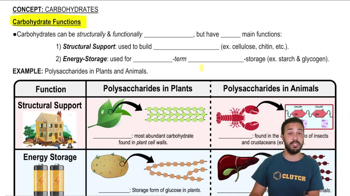Table of contents
- 1. Introduction to Biology2h 40m
- 2. Chemistry3h 40m
- 3. Water1h 26m
- 4. Biomolecules2h 23m
- 5. Cell Components2h 26m
- 6. The Membrane2h 31m
- 7. Energy and Metabolism2h 0m
- 8. Respiration2h 40m
- 9. Photosynthesis2h 49m
- 10. Cell Signaling59m
- 11. Cell Division2h 47m
- 12. Meiosis2h 0m
- 13. Mendelian Genetics4h 41m
- Introduction to Mendel's Experiments7m
- Genotype vs. Phenotype17m
- Punnett Squares13m
- Mendel's Experiments26m
- Mendel's Laws18m
- Monohybrid Crosses16m
- Test Crosses14m
- Dihybrid Crosses20m
- Punnett Square Probability26m
- Incomplete Dominance vs. Codominance20m
- Epistasis7m
- Non-Mendelian Genetics12m
- Pedigrees6m
- Autosomal Inheritance21m
- Sex-Linked Inheritance43m
- X-Inactivation9m
- 14. DNA Synthesis2h 27m
- 15. Gene Expression3h 20m
- 16. Regulation of Expression3h 31m
- Introduction to Regulation of Gene Expression13m
- Prokaryotic Gene Regulation via Operons27m
- The Lac Operon21m
- Glucose's Impact on Lac Operon25m
- The Trp Operon20m
- Review of the Lac Operon & Trp Operon11m
- Introduction to Eukaryotic Gene Regulation9m
- Eukaryotic Chromatin Modifications16m
- Eukaryotic Transcriptional Control22m
- Eukaryotic Post-Transcriptional Regulation28m
- Eukaryotic Post-Translational Regulation13m
- 17. Viruses37m
- 18. Biotechnology2h 58m
- 19. Genomics17m
- 20. Development1h 5m
- 21. Evolution3h 1m
- 22. Evolution of Populations3h 52m
- 23. Speciation1h 37m
- 24. History of Life on Earth2h 6m
- 25. Phylogeny2h 31m
- 26. Prokaryotes4h 59m
- 27. Protists1h 12m
- 28. Plants1h 22m
- 29. Fungi36m
- 30. Overview of Animals34m
- 31. Invertebrates1h 2m
- 32. Vertebrates50m
- 33. Plant Anatomy1h 3m
- 34. Vascular Plant Transport2m
- 35. Soil37m
- 36. Plant Reproduction47m
- 37. Plant Sensation and Response1h 9m
- 38. Animal Form and Function1h 19m
- 39. Digestive System10m
- 40. Circulatory System1h 57m
- 41. Immune System1h 12m
- 42. Osmoregulation and Excretion50m
- 43. Endocrine System4m
- 44. Animal Reproduction2m
- 45. Nervous System55m
- 46. Sensory Systems46m
- 47. Muscle Systems23m
- 48. Ecology3h 11m
- Introduction to Ecology20m
- Biogeography14m
- Earth's Climate Patterns50m
- Introduction to Terrestrial Biomes10m
- Terrestrial Biomes: Near Equator13m
- Terrestrial Biomes: Temperate Regions10m
- Terrestrial Biomes: Northern Regions15m
- Introduction to Aquatic Biomes27m
- Freshwater Aquatic Biomes14m
- Marine Aquatic Biomes13m
- 49. Animal Behavior28m
- 50. Population Ecology3h 41m
- Introduction to Population Ecology28m
- Population Sampling Methods23m
- Life History12m
- Population Demography17m
- Factors Limiting Population Growth14m
- Introduction to Population Growth Models22m
- Linear Population Growth6m
- Exponential Population Growth29m
- Logistic Population Growth32m
- r/K Selection10m
- The Human Population22m
- 51. Community Ecology2h 46m
- Introduction to Community Ecology2m
- Introduction to Community Interactions9m
- Community Interactions: Competition (-/-)38m
- Community Interactions: Exploitation (+/-)23m
- Community Interactions: Mutualism (+/+) & Commensalism (+/0)9m
- Community Structure35m
- Community Dynamics26m
- Geographic Impact on Communities21m
- 52. Ecosystems2h 36m
- 53. Conservation Biology24m
4. Biomolecules
Carbohydrates
Problem 2c
Textbook Question
Textbook QuestionWhat type of bond is formed between two sugars in a disaccharide? a. glycosidic linkage b. phosphodiester bond c. peptide bond d. hydrogen bond
 Verified step by step guidance
Verified step by step guidance1
Step 1: Understand the question. The question is asking about the type of bond that is formed between two sugar molecules when they combine to form a disaccharide.
Step 2: Recall the different types of bonds. A glycosidic linkage is a type of covalent bond that joins a carbohydrate (sugar) molecule to another group, which may or may not be another carbohydrate. A phosphodiester bond occurs in the backbone of DNA and RNA, linking the 3' carbon of one nucleotide to the 5' carbon of another. A peptide bond is a chemical bond formed between two molecules when the carboxyl group of one molecule reacts with the amino group of the other molecule, releasing a molecule of water. This is a dehydration synthesis reaction, and it is most common in the formation of proteins. A hydrogen bond is a weak bond between two molecules resulting from an electrostatic attraction between a proton in one molecule and an electronegative atom in the other.
Step 3: Apply your knowledge to the question. In the case of a disaccharide, two sugar molecules are being joined together. This is done through a glycosidic linkage, which is a type of covalent bond that joins a carbohydrate molecule to another group.
Step 4: Choose the correct answer. Based on the information above, the correct answer is a. glycosidic linkage.
Step 5: Review the concept. A glycosidic linkage is a type of covalent bond that joins a carbohydrate (sugar) molecule to another group. This is the type of bond that is formed between two sugar molecules in a disaccharide.
Recommended similar problem, with video answer:
 Verified Solution
Verified SolutionThis video solution was recommended by our tutors as helpful for the problem above
Video duration:
1mPlay a video:
Was this helpful?
Key Concepts
Here are the essential concepts you must grasp in order to answer the question correctly.
Disaccharides
Disaccharides are carbohydrates formed by the combination of two monosaccharides through a condensation reaction. This process results in the release of a water molecule and the formation of a covalent bond between the sugar units. Common examples of disaccharides include sucrose (glucose + fructose) and lactose (glucose + galactose).
Recommended video:
Guided course

Formation & Breakdown of Polysaccharides
Glycosidic Linkage
A glycosidic linkage is a type of covalent bond that connects two sugar molecules in a disaccharide. This bond is formed when the hydroxyl group of one sugar reacts with the anomeric carbon of another, resulting in the release of water. The specific type of glycosidic bond can vary depending on the orientation of the involved hydroxyl groups, influencing the properties of the resulting carbohydrate.
Recommended video:
Guided course

Formation & Breakdown of Polysaccharides
Types of Biological Bonds
In biology, various types of bonds play crucial roles in molecular interactions. Glycosidic linkages are specific to carbohydrates, while peptide bonds link amino acids in proteins, and phosphodiester bonds connect nucleotides in nucleic acids. Understanding these bonds is essential for grasping how biomolecules are structured and function within living organisms.
Recommended video:
Guided course

Biological Membranes

 4:53m
4:53mWatch next
Master Carbohydrates with a bite sized video explanation from Jason Amores Sumpter
Start learningRelated Videos
Related Practice













